
| Capability (C045):— representing_product_as_individual | Date: 2009/08/05 21:08:21 Revision: 1.27 |
This section provides a business level overview of this capability.
A realized product is an actual or future artefact that results from a process, such as manufacturing.
In PLCS, a distinction is made between:
the design of something; e.g. the specification, drawings, manufacturing details;
EXAMPLE The design of bicycle.
The design is identified and modelled as Part.
an artefact that is planned to be made or is being made from the design;
EXAMPLE The bicycle that has been ordered and scheduled for manufacture at a particular date.
NOTE Whilst the realized artefact has not been made, it is identified so that maintenance plans and facilities can be planned for it.
The planned artefact is referred to as a planned product and modelled as a Product_as_planned.
an artefact that has been made;
EXAMPLE The bicycle that has been delivered to a customer.
The realized artefact is referred to and modelled as a Product_as_realized,
This distinction is summarized in Figure 1 which shows the Part design, identified by a part number, and the artifacts manufactured from that design, identified by serial numbers.

Throughout the life of an artefact, changes will be made to it. For example, a safety modification may be made to a car, or a new set of spark plugs installed. In order to track the evolution of these changes the artefacts will be represented by versions where a version represents the artefact after a given change or modification has been applied. These representation of versions is shown in Figure 2.
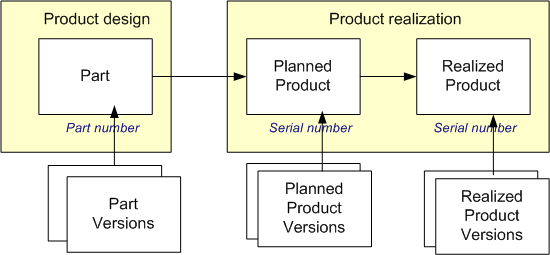
This capability describes the information required to represent the planned and realized artefacts. The representation of the design of the artefact is out of scope of this capability and is addressed in C002: representing_parts.
This section provides an overview of the information model that supports this capability.
An abstraction of an EXPRESS-G diagram for the product as realized model is shown in Figure 3 below.
NOTE This diagram is a summary of the information model.
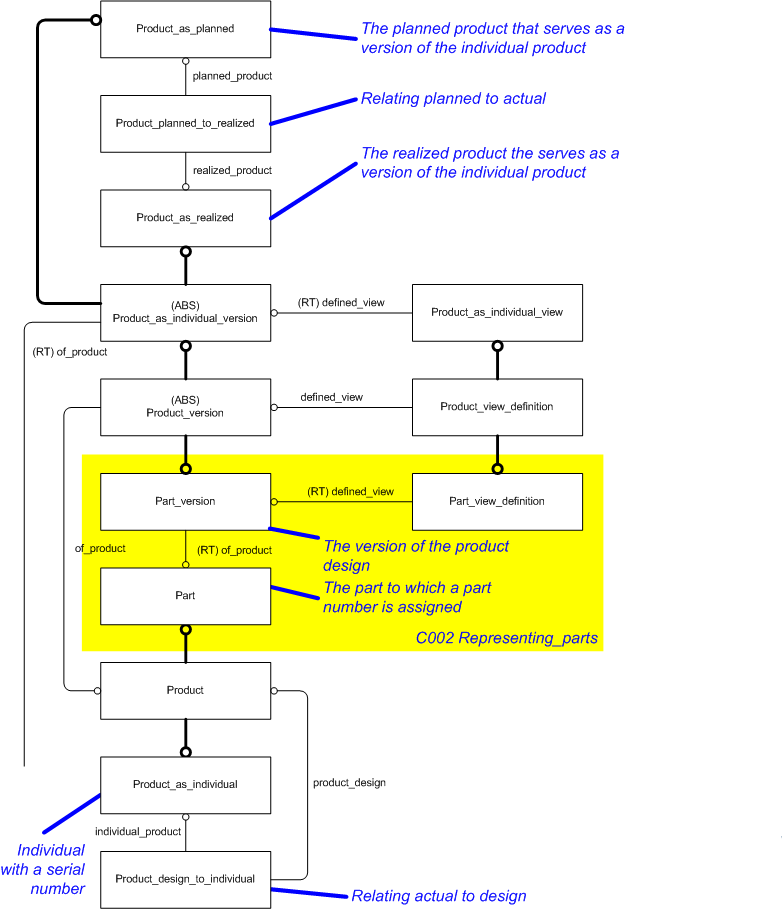
The key entities are:
If the artefact has been made from a known design, then the design is represented by a Part which is related to the artefact, the Product_as_individual, by a Product_design_to_individual relationship.
NOTE It is possible but not recommended to relate a Breakdown_element as the design of a Product_as_individual. by a Product_design_to_individual relationship.
An artefact is identified by a subclass of
"Product as individual identification code"
(urn:plcs:rdl:std:Product as individual identification code),
e.g. a serial number or batch code.
A serial number is represented by an
Identification_assignment
classified as
"Serial identification code"
(urn:plcs:rdl:std:Serial identification code)
that is assigned to the
Product_as_individual.
A batch number is instead classified as [Batch_identification_code]![]() Error RDL1: The class Batch_identification_code does not exist in RDL at URI urn:plcs:rdl:std. Check the dexlib/data/refdata/rdl_index.xml
Error RDL1: The class Batch_identification_code does not exist in RDL at URI urn:plcs:rdl:std. Check the dexlib/data/refdata/rdl_index.xml
(See C001: assigning_identifiers for further
details on identification).
If the proposed artefact is to be made from a design then it is related to the version of the design (Part_version) by the relation entity Product_design_version_to_individual.
If the artefact has been made from a design then it is related to the version of the design (Part_version) by the relation entity Product_design_version_to_individual.
The type of view is represented by a View_definition_context that is classified.
A more detailed EXPRESS-G diagram for the product as realized model is shown in Figure 4 below and explained in the following sections.
NOTE The EXPRESS-G is not complete.
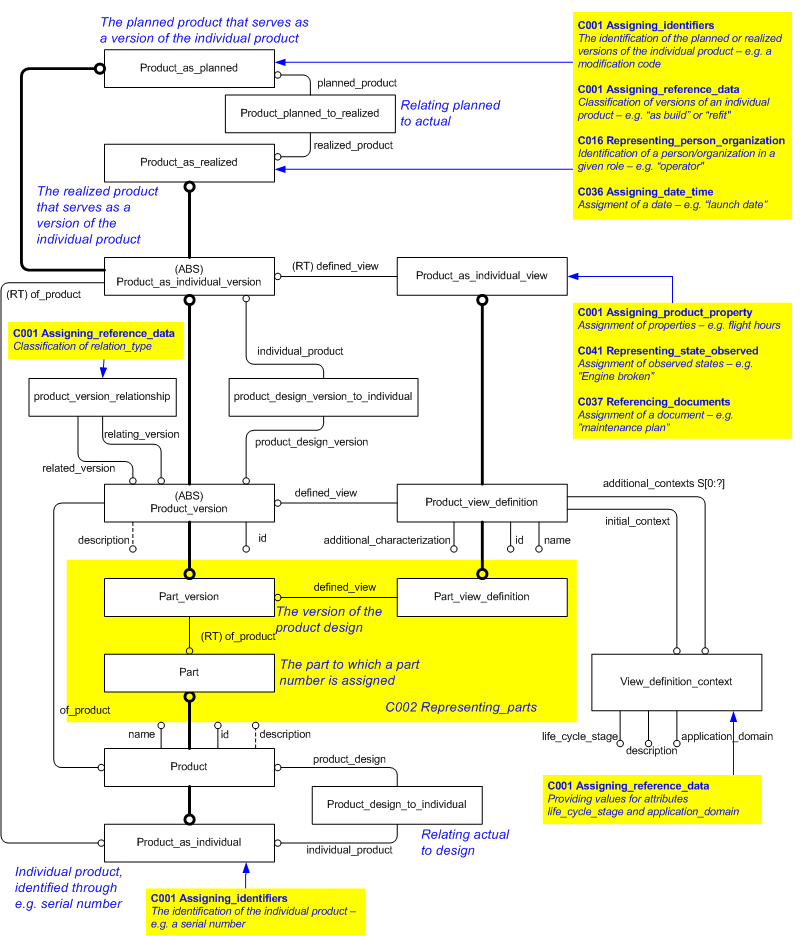
The diagram in Figure 5 shows the identification of a realized product. The realized product is represented by an instance of Product_as_realized. The identifier is represented by an instance of Identification_assignment (#5) classified as a "Version identification code" (urn:plcs:rdl:std:Version identification code). (See C001: assigning_identifiers for further details on identification).
The individual product for which this is a version, is represented by an instance of Product_as_individual. The identifier is represented by an instance of Identification_assignment (#13) classified as "Serial identification code" (urn:plcs:rdl:std:Serial identification code).
The part for which this is a realization occurrence is represented by an instance of Part. The part number is assigned by an instance of Identification_assignment (#6) classified as "Part identification code" (urn:plcs:rdl:std:Part identification code) (See C001: assigning_identifiers for further details on identification).
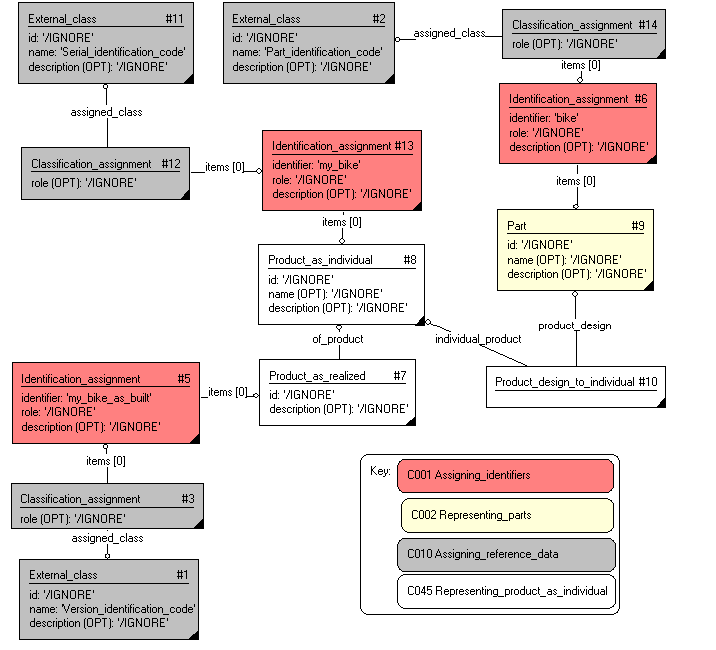
The diagram in Figure 6 shows the identification of a planned product together with the realization of that planned product. The planned product is represented by an instance of Product_as_planned; the realized product is represented by an instance of Product_as_realized; and the relationship between the Product_as_planned and the Product_as_realized is represented by and instance of Product_planned_to_realized.
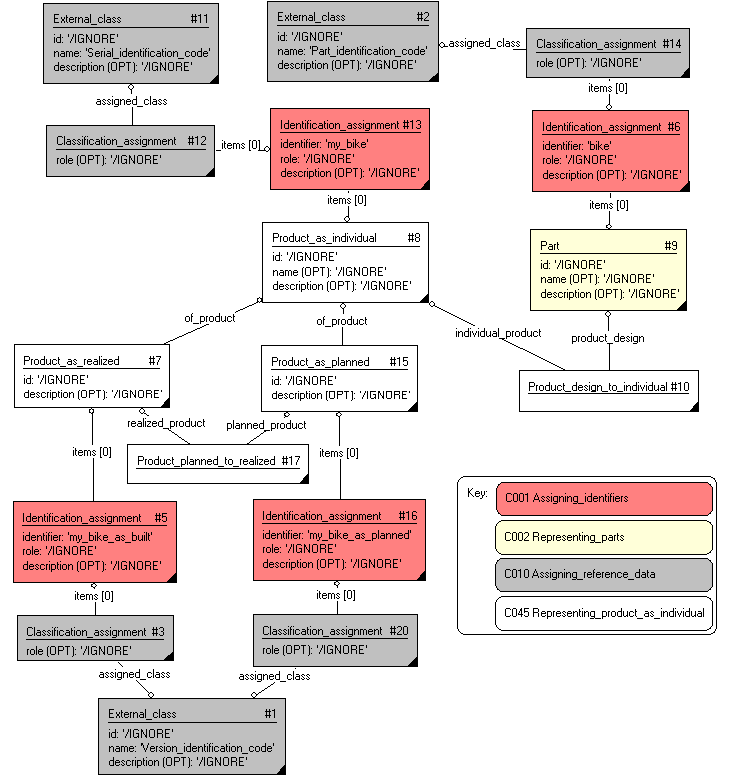
Each realized product can be viewed in different contexts, such as a design view and in-service view. Each view is represented by an instance of Product_as_individual_view and the context of the view is represented by an instance View_definition_context. The meaning of the context is provided by classifying the View_definition_context.
There are two aspects to the identification of the context. The "Application domain" and the "Life cycle stage".
EXAMPLE 'assembly study', 'digital mock-up', 'electrical design', 'mechanical design', 'preliminary design', 'process planning' are examples of application domains
EXAMPLE 'design phase', 'production', 'recycling phase' are examples of life cycle stages.
The attributes application_domain and life_cycle_stage of entity View_definition_context should not be used. Instead, the values of "Application_domain" and "Life cycle stage" should be represented using classification. The attributes of each View_definition_context, application_domain and life_cycle_stage, are set to '/IGNORE', and each View_definition_context is classified as a subclass of "Application domain" (urn:plcs:rdl:std:Application domain) and a subclass of "Life cycle stage" (urn:plcs:rdl:std:Life cycle stage).
An example is shown below in Figure 7. It shows two
"Application domain"
(urn:plcs:rdl:std:Application domain)
views of Bike. An
[Electrical_design]![]() Error RDL1: The class Electrical_design does not exist in RDL at URI urn:plcs:rdl:std. Check the dexlib/data/refdata/rdl_index.xml
Error RDL1: The class Electrical_design does not exist in RDL at URI urn:plcs:rdl:std. Check the dexlib/data/refdata/rdl_index.xml
view, and a
[Mechanical_design]![]() Error RDL1: The class Mechanical_design does not exist in RDL at URI urn:plcs:rdl:std. Check the dexlib/data/refdata/rdl_index.xml
Error RDL1: The class Mechanical_design does not exist in RDL at URI urn:plcs:rdl:std. Check the dexlib/data/refdata/rdl_index.xml
view.
Each view is in the
"Support stage"
(urn:plcs:rdl:std:Support stage) stage of the product life cycle.
The bike is represented by Product_as_individual (#8) and Product_as_realized (#7).
The mechanical support view of the bike is represented by
Product_as_individual_view (#34)
and an instance of
View_definition_context (#25)
that is classified as
[Mechanical_design]![]() Error RDL1: The class Mechanical_design does not exist in RDL at URI urn:plcs:rdl:std. Check the dexlib/data/refdata/rdl_index.xml
Error RDL1: The class Mechanical_design does not exist in RDL at URI urn:plcs:rdl:std. Check the dexlib/data/refdata/rdl_index.xml
by
External_class (#32).
The
View_definition_context (#25)
is also classified as
"Support stage"
(urn:plcs:rdl:std:Support stage)
by
External_class (#29).
The electrical support view of the bike is represented by
Product_as_individual_view (#35)
and an instance of
View_definition_context (#26)
that is classified as
[Electrical_design]![]() Error RDL1: The class Electrical_design does not exist in RDL at URI urn:plcs:rdl:std. Check the dexlib/data/refdata/rdl_index.xml
Error RDL1: The class Electrical_design does not exist in RDL at URI urn:plcs:rdl:std. Check the dexlib/data/refdata/rdl_index.xml
by
External_class (#31).
The
View_definition_context (#25)
is also classified as
"Support stage"
(urn:plcs:rdl:std:Support stage)
by
External_class (#29).
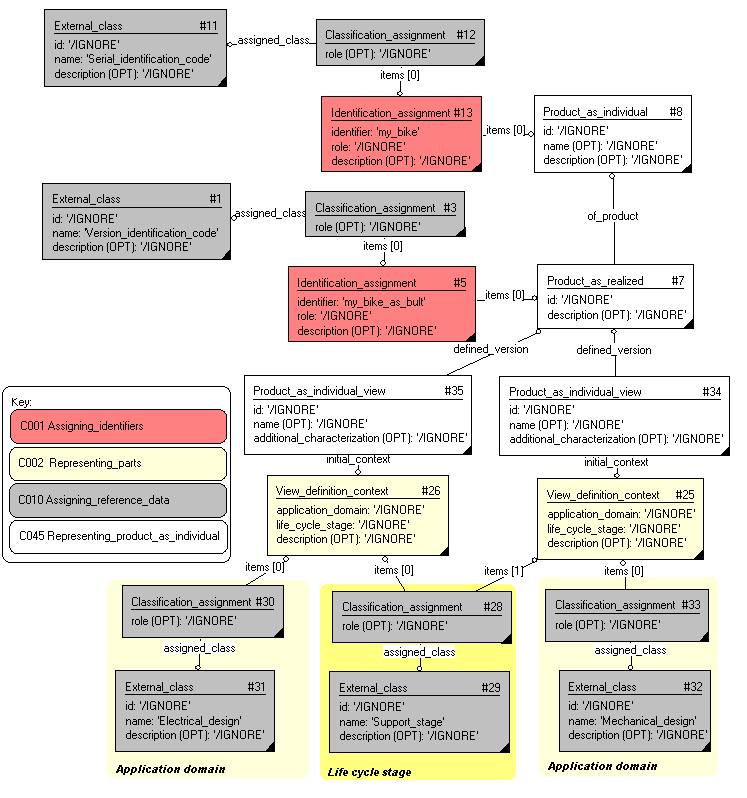
Properties that are predicted or observed on a Product_as_realized can be associated with a given view. The use of properties is described in C076: assigning_product_properties, C079: representing_properties_numerically and C080: representing_properties_textually
When a modification is made to a Product_as_realized a new version is created. This is represented by creating a new instance of a Product_as_realized and relating it back to the previous Product_as_realized by a Product_version_relationship, classified using external reference data. This represents a version history.
There are three types of relationships between Product_as_realized used to represent the version history:
Sequential relationship: This indicates that one version follows or is derived from the previous version of the same Product_as_individual. The relating_version is the preceding version (Product_as_realized) and the related_version is the subsequent version (Product_as_realized). Both versions must be associated with the same Product_as_individual. A Product_as_realized may have at most one preceding and one subsequent version.
A sequential relationship is represented by a
Product_version_relationship
classified using external reference data as
[Sequential_version_relationship]![]() Error RDL1: The class Sequential_version_relationship does not exist in RDL at URI urn:plcs:rdl:std. Check the dexlib/data/refdata/rdl_index.xml
Error RDL1: The class Sequential_version_relationship does not exist in RDL at URI urn:plcs:rdl:std. Check the dexlib/data/refdata/rdl_index.xml
NOTE For physical products, the hierarchical relationship may not be easy to understand or use, but for software products it is often used.
A hierarchical relationship is represented by a
Product_version_relationship
classified using external reference data as
[Hierarchical_version_relationship]![]() Error RDL1: The class Hierarchical_version_relationship does not exist in RDL at URI urn:plcs:rdl:std. Check the dexlib/data/refdata/rdl_index.xml
Error RDL1: The class Hierarchical_version_relationship does not exist in RDL at URI urn:plcs:rdl:std. Check the dexlib/data/refdata/rdl_index.xml
EXAMPLE 'Rev. 1.1' and 'Rev. 1.2' are subordinates of 'version 1'.
Derived relationship: This indicates that a version is derived from a version of a different Product_as_individual. The relating_version is the preceding version (Product_as_realized) and the related_version is the derived version (Product_as_realized). Each versions is associated with the different Product_as_individuals.
A derived relationship is represented by a
Product_version_relationship
classified using external reference data as
[Derived_version_relationship]![]() Error RDL1: The class Derived_version_relationship does not exist in RDL at URI urn:plcs:rdl:std. Check the dexlib/data/refdata/rdl_index.xml
Error RDL1: The class Derived_version_relationship does not exist in RDL at URI urn:plcs:rdl:std. Check the dexlib/data/refdata/rdl_index.xml
The version code is provided assigning an identifier classified as "Version identification code" (urn:plcs:rdl:std:Version identification code) to the Product_as_realized. (See C001: assigning_identifiers for further details on identification).
An example of two versions of a bicycle is shown in Figure 8.
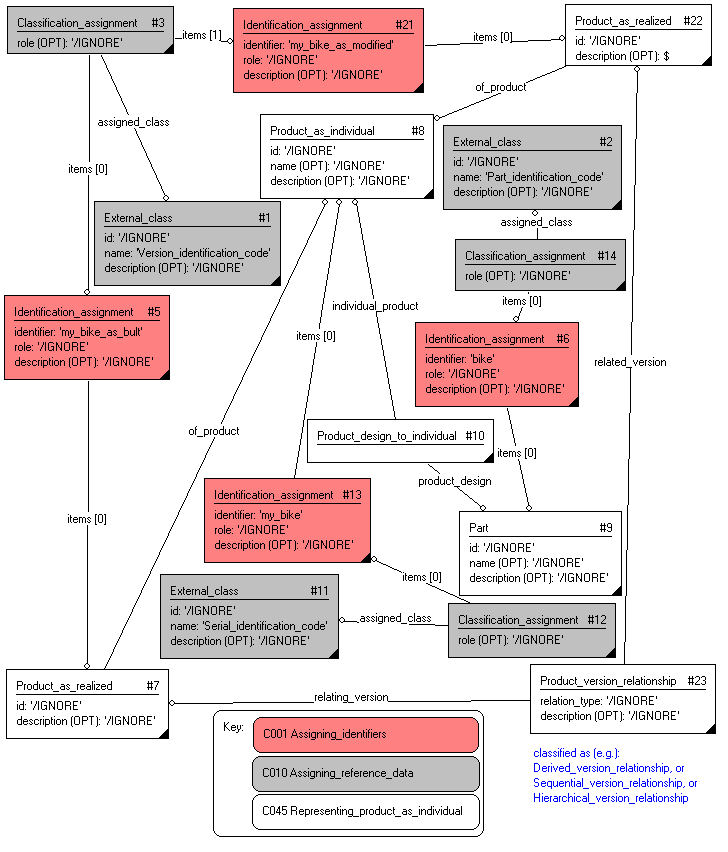
No versioning of Individual Products
Many organizations do not version individual products, i.e. they either change the identifier of the individual product after a major modification, or they simply do not keep a (digital) history of what has happened to the real product. For such organizations, it is recommended that the identification of the Product_as_realized is set to "/NULL", i.e. the attribute identifier of entity Identification_assignment contain the string "/NULL" (see C001: assigning_identifiers), to indicate that no version information is relevant or intended. In this case only a single product_as_realized for the product_as_individual is possible.
For such organizations, some of the version relationships described here are no longer applicable, and relationships between Product_as_individuals may be more appropriate, e.g. a Product_as_individual may be derived from another Product_as_individual. The Product_relationship entity may be used to describe such relationships, using the same external reference data classes.
If the value of the identification attribute for a Identification_assignment assigned to a Product_as_realized is the string '/NULL', postprocessors should use this as an indication that the sending system or business process does not support versioning of Product_as_individuals.
A realized product can be related back to the version of the design from which it was created. This is shown in Figure 9 which shows an actual bike, represented by an instance of Product_as_individual (#7) related to the design, represented by an instance of a Part (#9) by an instance of a Product_design_to_individual (#10); and an as built version of that individual a bike, represented by an instance of Product_as_realized (#8) related to the version of the design, represented by an instance of a Part_version (#23) by an instance of a Product_design_version_to_individual (#24)
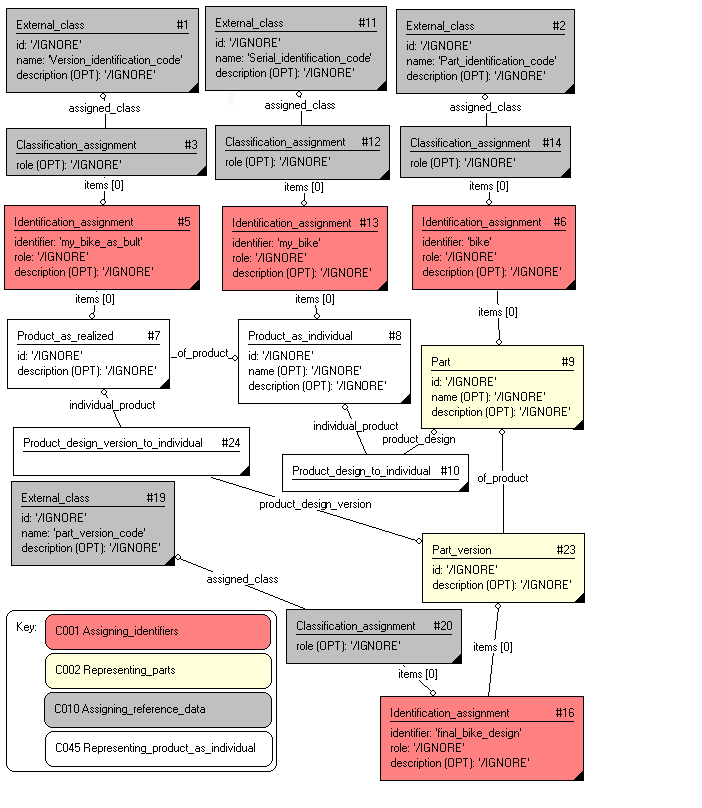
NOTE It is possible but not recommended to relate a Breakdown_element as the design of a Product_as_individual. by a Product_design_to_individual relationship.
This section specifies how the information model can be further characterized by the assignment of additional information such as dates, approvals and people or organizations.
The following characterizations may apply.
A person or organization can be assigned to Product_as_individual in a given role, such as "owner". This is represented by assigning a Person_in_organization or Organization (using the relationship Organization_or_person_in_organization_assignment) to the Product_as_individual. The role of the assignment is represented by classifying the assignment by the use of reference data (see C010: assigning_reference_data). In the case where the Product_as_individual Person_in_organization is the owner of the Product_as_individual the Organization_or_person_in_organization_assignment is classified as "Owner of" (urn:plcs:rdl:std:Owner of). Other possible classifications are:
NOTE The assignment of a person or organization is described in the capability C016: representing_person_organization.
Dates can be assigned to Product_as_individual, Product_as_planned and Product_as_realized in a given role, such as "Date actual creation" (urn:plcs:rdl:std:Date actual creation). This is represented by using the relationship Date_or_date_time_assignment) to assign a date in a given role. The role of the assignment is represented by classifying the assignment by the use of reference data (see C010: assigning_reference_data.
NOTE The assignment of dates is described the capability C036: assigning_date_time.
Documents can be assigned to Product_as_individual_view in a given role, such as "maintenance instructions". This is represented by using the Document_assignment relationship as described in capability C005: representing_documents. The role of the assignment is represented by classifying the assignment by the use of reference data (see C010: assigning_reference_data.
Issue: NN-1 by Nigel Newling (2005-11-17) [minor_technical, closed] - {Type = contents}
Make it clear in the text that the relation_type attribute on Product_version_relationship is not populated by the actual value but classified.Comment: (Peter Bergström 2007-01-24)
Fixed in text and detailed Express-G diagram.
An individual product may be broken down into its constituents, very much in the same way as type products (assemblies) can, and an individual product may be part of a product structure as a constituent (similar to parts). PLCS provides two different methods to do this.
The most flexible method to use for describing structures of individual products is to use a Breakdown of an individual product, where Breakdown_elements are used to represent the logical element in a structure. A Breakdown_element can then be realized as an individual product (or its version: Product_as_realized) through Breakdown_element_realization.
Breakdowns offer all abstraction levels needed to represent realization of logical concepts (breakdown_elements), "functional locations", slots, "virtual parts", and whatever a business domain may require in terms of representing different product structures and their interrelationships. It covers the requirements from early design stages and systems engineering, through design and manufacturing, the in-support phases, and recycling.
The use of Breakdowns, Breakdown_elements, and Breakdown_element_realizations to create structures of individual products is described in C004: representing_breakdown_structure.
An alternative method is to build a structure using instances of Next_assembly_usage and combine the individual products directly into an assembly (or possibly better: disassembly structure). This approach is fine when the scope of the structure is narrower, e.g. to create a single maintenance structure of a product, and where there are no requirements to integrate with other structures (e.g. breakdowns).
This approach is further described in C003: representing_assembly_structure.
The following sections define a set of templates for the capability, where a template is a specification of a set of entities that need to be instantiated to represent a given set of information.
This section specifies the template representing_product_as_realized.
NOTE An explanation of a template and the associated instantiation path is provided in the Template overview section.
This template describes the representation of a real physical product, an artifact, using the Product_as_realized entity.
It enables the identification of the physical product and its relation to the Part where the Part represents the design or specification that was used to manufacture the physical product, normally identified by a part number. The template also defines the how reference data, dates, properties, documents, etc. are assigned to the physical product.
NOTE If an organization does not version Product_as_individuals, it is recommended that the identification of the Product_as_realized is set to "/NULL", i.e. the attribute identifier of entity Identification_assignment contain the string "/NULL" (see C001: assigning_identifiers), to indicate that no version information is relevant or intended. In this case, (historical) changes to the real product cannot be tracked without changing the identifier of the product_as_individual (e.g. the serial number).
NOTE If the Part is not known, then it is recommended to use the template referencing_part with the identifier parameters set to "/NULL" to indicate that the Part is not known.
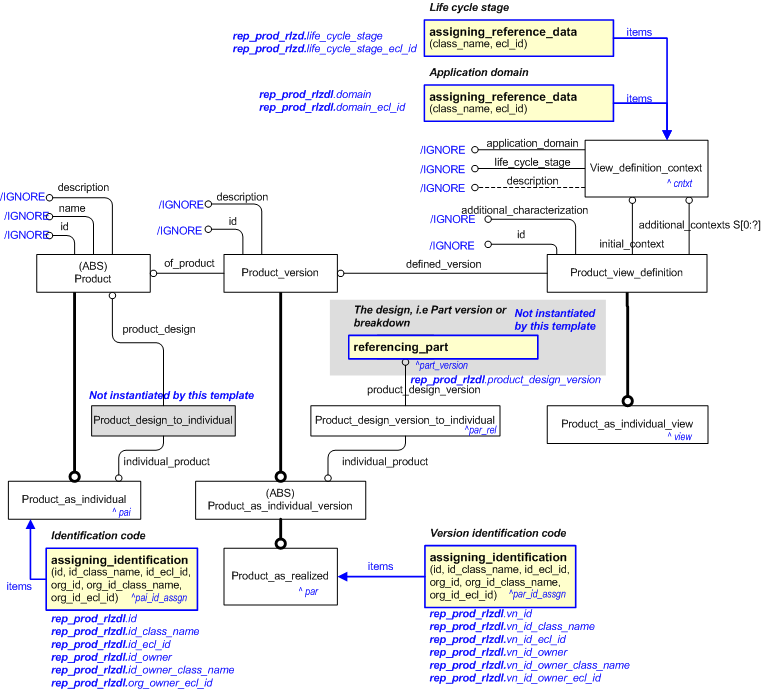

target
is the parameter to which the
Product_as_individual
is bound.
target
is the parameter to which the
Identification_assignment
is bound.
target
is the parameter to which the
Product_as_realized
is bound.
target
is the parameter to which the
Identification_assignment
is bound.
target
is the parameter to which the
Product_design_version_to_individual
is bound.
target
is the parameter to which the
Product_as_individual_view
is bound.
target
is the parameter to which the
View_definition_context
is bound.
| Entity in path | Value | Inherited from |
| Product_as_individual.id | '/IGNORE' | Product.id |
| Product_as_individual.name | '/IGNORE' | Product.name |
| Product_as_individual.description | '/IGNORE' | Product.description |
| Product_as_realized.id | '/IGNORE' | Product_version.id |
| Product_as_realized.description | '/IGNORE' | Product_version.description |
| Product_as_individual_view.id | '/IGNORE' | Product_view_definition.id |
| Product_as_individual_view.name | '/IGNORE' | Product_view_definition.name |
| Product_as_individual_view.additional_characterization | '/IGNORE' | Product_view_definition.additional_characterization |
| View_definition_context.life_cycle_stage | '/IGNORE' | — |
| View_definition_context.application_domain | '/IGNORE' | — |
| View_definition_context.description | '/IGNORE' | — |
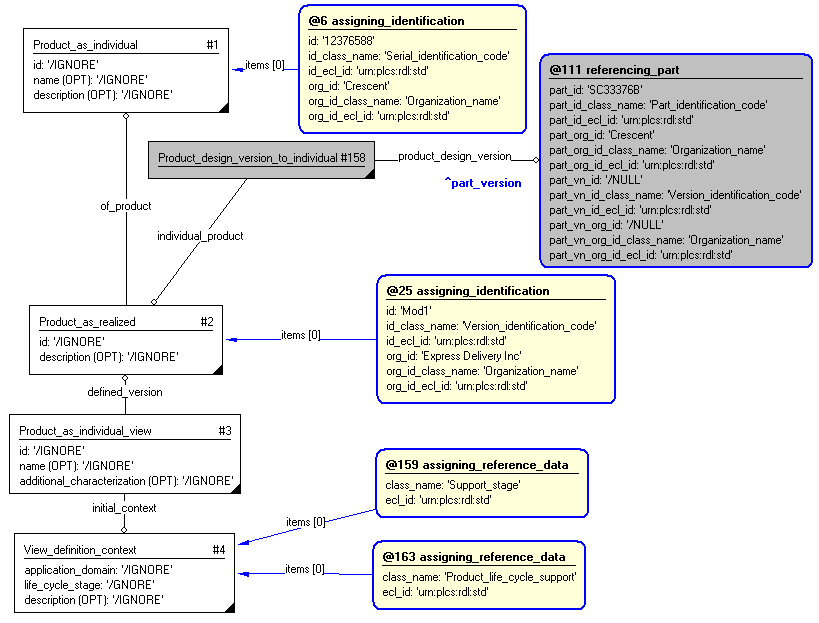
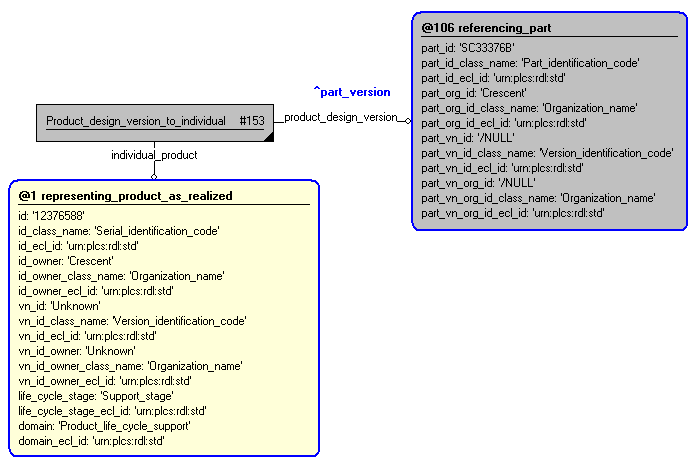
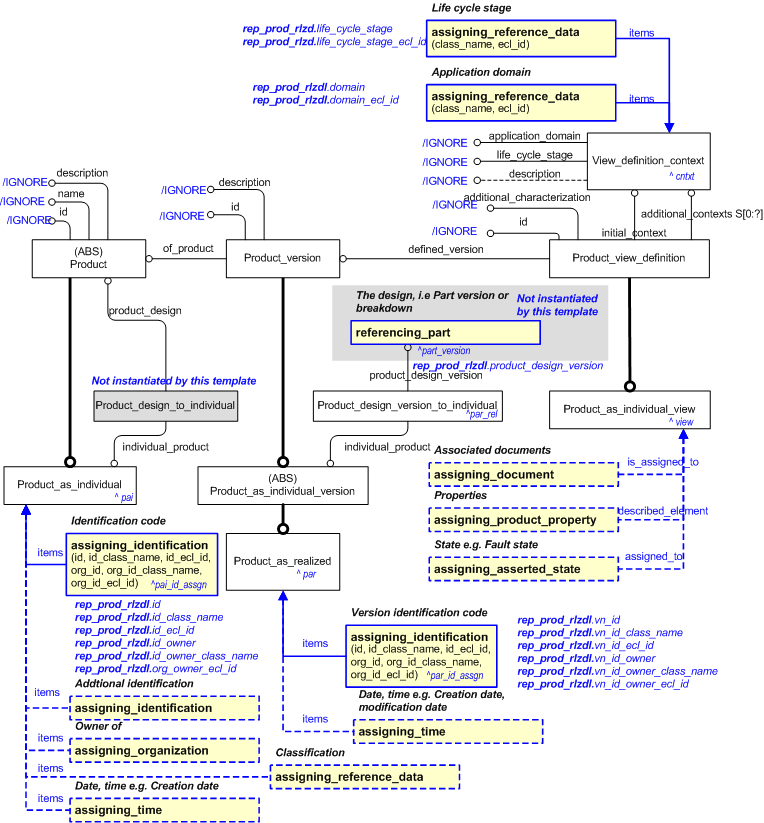
NOTE this characterization is optional.
Classifications and codes may be assigned to a Product_as_individual through external reference data. See Figure 5 for an Express-G example.
A class of a Product_as_individual is represented by using the template assigning_reference_data assigned to Product_as_individual.
A code of a Product_as_individual is represented by using the template assigning_code assigned to Product_as_individual.
NOTE this characterization is optional.
Dates and time can be associated with a Product_as_realized by using the templates assigning_time. See Figure 5 for an Express-G example.
A creation date is commonly assigned to the template representing_product_as_realized. The date and time assignment is classified as: "Date actual creation" (urn:plcs:rdl:std:Date actual creation) to indicate that it is the date (and time) when the Product_as_realized was actually created, i.e. a modification was made to the physical product (without changing its serial number).
If earlier Product_as_realized exists for the same Product_as_individual, it is implied that they are no longer existent. In any system which manages historical data, the earlier Product_as_realized should be marked as historical.
NOTE this characterization is optional.
An organization can be associated as an owner of the real product by using the template assigning_organization. See Figure 5 for an Express-G example.
The assignment of the organization (Organization_or_person_in_organization_assignment) is classified as: "Owner of" (urn:plcs:rdl:std:Owner of) to indicate that this organization owns the real product.
NOTE this characterization is optional.
A real product may have specific properties and documents assigned to it, as well as states, through the use of templates assigning_product_property (for properties), assigning_document (for documents), assigning_assessed_state (for assessed states), and assigning_asserted_state (for asserted states). See Figure 5 for an Express-G example.
All these are assigned to Product_as_individual_view. An example is shown in Figure 5.
This section specifies the template referencing_product_as_realized.
NOTE An explanation of a template and the associated instantiation path is provided in the Template overview section.
This template describes how to relate and identify product_as_individual with a version of product_as_realized.
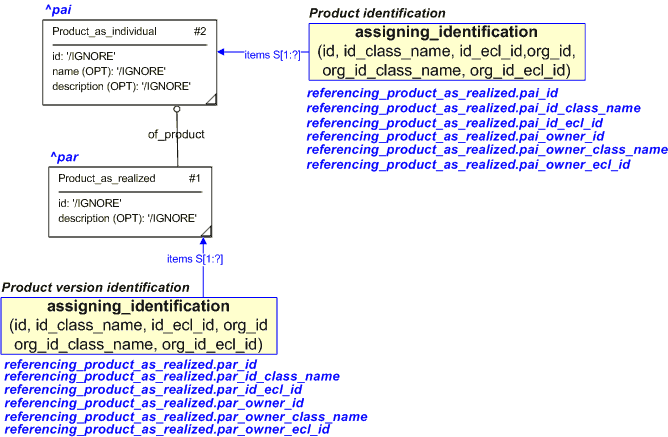

target
is the parameter to which the
Product_as_individual
is bound.
target
is the parameter to which the
Product_as_realized
is bound.
| Entity in path | Value | Inherited from |
| Product_as_individual.id | '/IGNORE' | Product.id |
| Product_as_individual.name | '/IGNORE' | Product.name |
| Product_as_individual.description | '/IGNORE' | Product.description |
| Product_as_realized.id | '/IGNORE' | Product_version.id |
| Product_as_realized.description | '/IGNORE' | Product_version.description |


This section specifies the template referencing_product_as_individual.
NOTE An explanation of a template and the associated instantiation path is provided in the Template overview section.
This template describes how to represent a reference to a serialized product by its identification, without a reference to its realization or modification status.
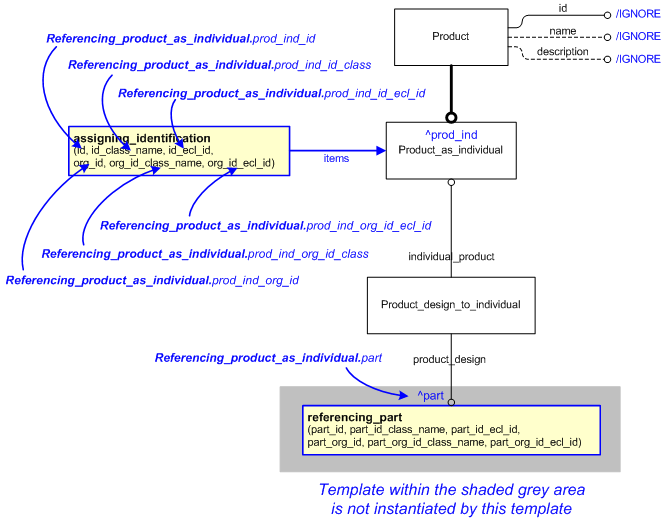

target
is the parameter to which the
Product_as_individual
is bound.
| Entity in path | Value | Inherited from |
| Product_as_individual.id | '/IGNORE' | Product.id |
| Product_as_individual.name | '/IGNORE' | Product.name |
| Product_as_individual.description | '/IGNORE' | Product.description |
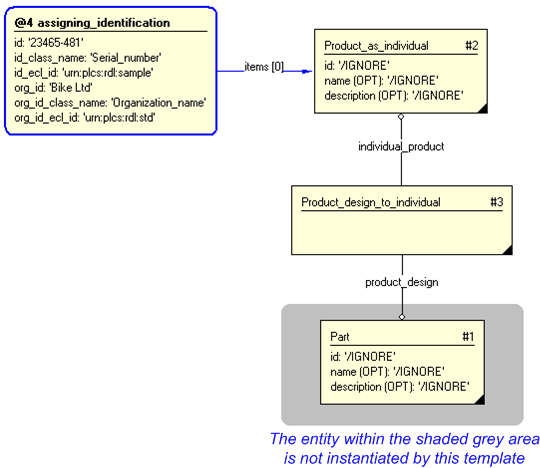
The instance model in STEP XML exchange file format (ISO 10303 Part 28 ed.2 syntax) is:#1 = PART('/IGNORE','/IGNORE','/IGNORE'); #2 = PRODUCT_AS_INDIVIDUAL('/IGNORE','/IGNORE','/IGNORE'); #3 = PRODUCT_DESIGN_TO_INDIVIDUAL(#1,#2); #5 = IDENTIFICATION_ASSIGNMENT('23465-481','/IGNORE',$,(#2)); #7 = CLASSIFICATION_ASSIGNMENT(#9,(#5),'/IGNORE'); #9 = EXTERNAL_CLASS('/NULL','Serial_number','/IGNORE',#10); #10 = EXTERNAL_CLASS_LIBRARY('urn:plcs:rdl:sample',$); #12 = ORGANIZATION('/IGNORE','/IGNORE'); #14 = IDENTIFICATION_ASSIGNMENT('Bike Ltd','/IGNORE','/IGNORE',(#12)); #16 = CLASSIFICATION_ASSIGNMENT(#18,(#14),'/IGNORE'); #18 = EXTERNAL_CLASS('/NULL','Organization_name','/IGNORE',#19); #19 = EXTERNAL_CLASS_LIBRARY('urn:plcs:rdl:std',$); #20 = ORGANIZATION_OR_PERSON_IN_ORGANIZATION_ASSIGNMENT(#12,'/IGNORE',(#5)); #22 = CLASSIFICATION_ASSIGNMENT(#24,(#20),'/IGNORE'); #24 = EXTERNAL_CLASS('/NULL','Owner_of','/IGNORE',#19);
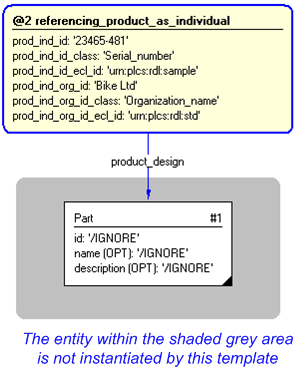
This section specifies the template representing_product_as_realized_structure.
NOTE An explanation of a template and the associated instantiation path is provided in the Template overview section.
This template describes how to represent a structure of realized products.
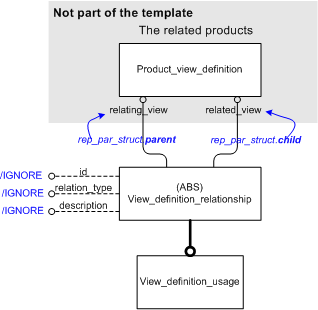

target
is the parameter to which the
View_definition_usage
is bound.
| Entity in path | Value | Inherited from |
| View_definition_usage.id | '/IGNORE' | View_definition_relationship.id |
| View_definition_usage.relation_type | '/IGNORE' | View_definition_relationship.relation_type |
| View_definition_usage.description | '/IGNORE' | View_definition_relationship.description |

The instance model in STEP XML exchange file format (ISO 10303 Part 28 ed.2 syntax) is:#1 = TASK_METHOD($,$,$,$,()); #2 = EXTERNAL_CLASS('/IGNORE','Safety_critical',$,#3); #3 = EXTERNAL_CLASS_LIBRARY('urn:plcs:rdl:std',$); #4 = CLASSIFICATION_ASSIGNMENT(#2,(#1),'/IGNORE');


NOTE this characterization is optional.
The date when the Work_order and the Directed_activity was issued can be represented by assigning a date (using the relationship Date_or_date_time_assignment) to the Work_order and the Directed_activity using the assigning_calendar_date template with the Date_time being classified as a type of "Date actual release" (urn:plcs:rdl:std:Date actual release).
NOTE The assignment of dates is described the capability C036: assigning_date_time.
This capability "Representing an individual product" is related to the following capabilities:
This capability "Representing an individual product" is dependent on the following capabilities:
The following classes of reference data are required for this capability:
© OASIS 2010 — All rights reserved